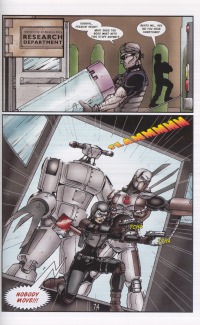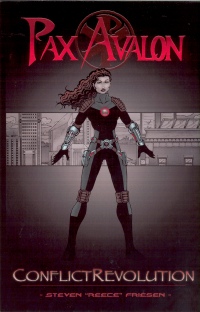| ________________
CM . . . . Volume XV Number 21. . . .June 12, 2009.
excerpt:
 Out of guilt came Pax Avalon, a graphic novel/comic, featuring an ensemble cast of crime-fighters with superheroic powers, starring Julianna Embry, a.k.a. Pax Avalon. Julianna/Pax is a member of an elite team of operatives who assist the regular police force of Avalon City (a large urban centre, somewhere in North America). Each of her colleagues is identified by a soubriquet which represents his or her special expertise: Doc is the team leader, a surgeon who performs astonishing medicine under crisis conditions, Mech is a genius at creating specialized machinery, Badge is a combat specialist, and Fireguard is a firefighter who is the go-to guy for any incendiary disaster. Unlike the others on the ACSO (Avalon City Special Operations team), Pax is a volunteer and has a special gift: she is able to heal by touch, and she does so by assuming the ills of the afflicted individual. This former gold medal-winning Olympian gymnast is also a Christian whose studio is a former church building. But as Pax, her mission is peace, and in full uniform, she bears the "Chi-Rho" insignia of Christ, much as medieval knights bore a large red cross on the white tabards covering their chain mail. Out of guilt came Pax Avalon, a graphic novel/comic, featuring an ensemble cast of crime-fighters with superheroic powers, starring Julianna Embry, a.k.a. Pax Avalon. Julianna/Pax is a member of an elite team of operatives who assist the regular police force of Avalon City (a large urban centre, somewhere in North America). Each of her colleagues is identified by a soubriquet which represents his or her special expertise: Doc is the team leader, a surgeon who performs astonishing medicine under crisis conditions, Mech is a genius at creating specialized machinery, Badge is a combat specialist, and Fireguard is a firefighter who is the go-to guy for any incendiary disaster. Unlike the others on the ACSO (Avalon City Special Operations team), Pax is a volunteer and has a special gift: she is able to heal by touch, and she does so by assuming the ills of the afflicted individual. This former gold medal-winning Olympian gymnast is also a Christian whose studio is a former church building. But as Pax, her mission is peace, and in full uniform, she bears the "Chi-Rho" insignia of Christ, much as medieval knights bore a large red cross on the white tabards covering their chain mail.
Steven Friesen pays homage to the superhero comics of his youth in both the drawing style of his characters, and in the crises they must resolve. There is plenty of futuristic technology at his crime-fighters� disposal, and in true superhero style, the men have muscles on muscles, and the women have curves, because "the currency of comics is power, but the symbol of that power is curves." (Preface) Finally, someone has provided an explanation for those perfectly-proportioned superwomen! However, Pax Avalon is more than just a tribute to the genre which was once a guilty pleasure (for more people than Steve Friesen!); he has also used it as a vehicle for a story in which violence is not the solution, and special power (especially a God-given talent) must be respected and used for good. Like Steve Friesen, I grew up in a home where reading was encouraged but comics (except for the ones which appeared in the daily newspaper) were not. So, I am really unfamiliar with superhero comics. And, although I do remember comics-style re-telling of Bible stories in my Catechism (Catholic religious education) classes, I have never, until now, read a Christian-themed contemporary comic/graphic novel. I decided that I needed the opinion of someone more knowledgeable than I. So, I asked Paul B., a Senior Years Computer / ICT Teacher at a major Winnipeg high school and connoisseur of comics and graphic novels, to read Pax Avalon, and to provide a response. His responses are in quotation marks..His responses are in "quotation� marks. Wow, Batman! What a response! Like me, Paul B. appreciated a female lead, "perhaps overdone in comics today, but the big difference in Pax Avalon is, of course, the strong faith of the heroine. Looking good isn't a bad thing, either." Much to my surprise, I found myself carried along "by an action-filled storyline which succeeds in not being violence-filled - no small feat, given the prevailing levels of violence in comics." When I started reading, I wondered just how Christianity would be worked into the story. Pax Avalon has a "strong Christian message without the soapbox, so to speak. Pax is a different character than the other members of her team because she thinks, acts, and believes differently than they do, not because she pulls out a Bible and preaches on every other page. Pax Avalon gets its message across without quoting even a single verse. Quite the accomplishment." For me, most remarkable was the way in which prayer was integrated into the story; regardless of one�s religious tradition, if prayer is part of one�s life, it can take a form different from the formal and ritualized. Paul B. stated it well: �If you�re going to have a Christian character, and do it properly, then depicting prayer in their life is a must. . . When confronted with situations which get out of hand, Pax prays naturally, just as Christians in the real world do." The sub-title of this novel is "conflict revolution," and what is revolutionary is that Pax can intervene in a crime-in-progress, without using violence. Paul B. remarked: "It works. It frustrated my expectations for at least some violence on the part of a title character, but it did work. Again, the beliefs of the character change the outcome of what could have been just another Kung-Fu mashup in just another comic on the shelves. Kudos for doing something different, Mr. Friesen!" So what did Paul B. find less-than-awesome? He stated, "Forgive my nit-picking, Joanne, but I have to lapse into `Fanboy mode � at this point . . . the art. Good, considering that Steven Friesen drew it himself, but . . . Comics are often judged according to their art. In fact, good art often redeems or masks a bad story, or can even take the place of a story altogether. In the case of Pax Avalon, I think the story is innovative, engaging, and a plain good read, but it should have art of a higher calibre. People who have read a lot of comics can detect quality when they read it, but to make it available to a wider audience, I think that the art should be rendered by someone else, in subsequent volumes." An aspect of the book that really didn�t quite work for me was the cross-referencing to asterisked dialogue on many pages of the book. The asterisked item is referenced in "Thinking It Through," a page of open-ended questions, which challenge the reader to think about the issue raised by the item. As a reader, I found this intrusive, although it might work to generate response if the book were being read by a study group (Steve Friesen has worked as a youth pastor, so I am thinking that having youth groups read and discuss the book might have been the intention here.) And only a true comics connoisseur would notice details such as "an Out-of-Continuity Scene Change", or the time when Pax claims that "her gauntlets have enough air pressure for only two shots of her grappling line (p. 10). However, during the second half of the story, she certainly seems to be swinging from building to building, a la Spider-Man or Batman." But, these are mere quibbles. I wondered if the story would appeal equally to guys and girls, or if there would be a definite gender split. I liked the idea of a strong female character, and thought the female lead would make the story and its concept appealing to female readers. Paul B. thought that "guys will pick it up for the �action� angle, and probably like it. Girls stand less of a chance of picking it up to start, but, having made it past the first 10 or 12 pages, they will likely be hooked." Finally, I wondered about the other aspect of audience: "Will this be a �niche market� book (i.e. only students from a "Big C" Christian background will like it), or will mainstream comics readers enjoy it too?" Paul B. wrote that "Christian characters always seem a bit �cut and pasted� into most media contexts: television shows, movies, books, etc. On the one hand, it leads to �speed-bumps� in our otherwise uninterrupted stream of entertainment, as characters who are true to Christian ideals will, by definition, have at least some problems with issues such as homicide, infidelity, consumerism, corruption, etc., all of which form the basis for much of our entertainment.� �On the other hand, Jesus did promise that His followers would be seen as freaks by the world (OK, perhaps "freaks" is a paraphrase, but the idea stands), so why should entertainment, which is supposed to have some verisimilitude, be any different? Pax Avalon succeeds because it is different; if you don't want a comic with a Christian character, change the channel.� Well, Friesen promises a sequel. Pax Avalon "Birthright", and I look forward to reading it. Pax Avalon is an interesting addition to the graphic novel collection of any middle or high school, and definitely an item worth acquiring by schools following a Christian tradition. Recommended. Joanne Peters is a teacher-librarian at Kelvin High School in Winnipeg, MB, and Paul B. is an Computer/ICT Teacher at "X" High School, which, by all reports, is also in Winnipeg, MB.
To comment on this title or this review, send mail to cm@umanitoba.ca. Copyright © the Manitoba Library Association. Reproduction for personal use is permitted only if this copyright notice is maintained. Any other reproduction is prohibited without permission.
NEXT REVIEW | TABLE OF CONTENTS FOR THIS ISSUE- June 12, 2009. AUTHORS | TITLES | MEDIA REVIEWS | PROFILES | BACK ISSUES | SEARCH | CMARCHIVE | HOME |
